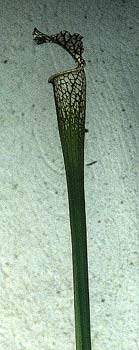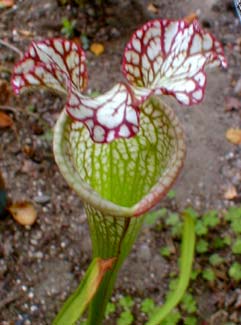
White Topped Pitcher Plant
"We knelt beside still waters,
As dark as dark could be,
And plucked the strange swamp-lilies,
Their fretted ivory."
-Myra Morris
(1893-1966)
(1893-1966)
Early in 2002, I started a little carnivorous-plant bog garden, & didn't yet know for sure how it would work out, though I was pretty certain I had figured out the basics, & it would do okay.
 I buried a small black plastic pool with its rim barely below the soil so there's no evidence of the plastic, but it keeps the roots of the pitcher plants wet at all times, providing the requisit zero drainage.
I buried a small black plastic pool with its rim barely below the soil so there's no evidence of the plastic, but it keeps the roots of the pitcher plants wet at all times, providing the requisit zero drainage.The soil medium is half sand & half peat. It is fairly sterile, as pitcher plants get their primary nourishment from catching insects. The plants can be killed by too rich a soil & should never be fertilized. Pitcher plants like to be watered from overhead, some varieties wanting to get plenty of water inside their pitchers where trapped insects will drown.
I tried carnivorous plants previously as houseplants but they failed. They're really best outdoors, & are a lot hardier in the garden than in the house. The drawback is they're fragile in the presence of animals. A visiting racoon three times savaged my little carnivore bog, forcing me to rearrange an aquatic bowl & move the buried bog-spot. A dog or cat can do just as much accidental damage to these easily mangled plants.
The top photo is from June (2002) showing a leaf of a White Topped Pitcher Plant (Sarracenia leucophylla), which sprang up to a foot & a half tall. The bottom portion of the tube is pale green, but the upper pitcher & lid are white with faint purple lace. It also produces gorgeous wine-red flowers on long bendy stalks.
After the racoon beat down the white pitchers during its first year, it went a year with hardly any growth, having a hard time recovering from its utter destruction. But the little rhizomes of Sarracenia species can be very longlived, so I never gave up on it. In 2003 it only produced slim incomplete leaves that couldn't possibly have fed the rhizome properly, so it was definitelyh a worry. Without the pitchers, it cannot feed, & without feeding, it might not live.
Because the more aggressive Darlingtonia californica was spreading & taking over the little bog & out-competing the White Top, & because the racoon kept returning to the trample through the same area, I set up a second bog at the end of summer, 2003, & moved the White Top to the newer bog together with other Sarracenias.
The minimalist rhizome is much more for anchoring the plant & taking up moisture from the bog, not for taking in nutrients. It feeds very slightly through foliar absorption, so I sprayed 2003's incomplete leaves with a weak nutrient tea a few times, though uncertain this would help. In 2004 it sprang back to life. The second photo is from October (2004) looking down the throat of the specialized insect-trapping leaf.
White Topped Pitcher Plant is native of the deep south from Georgia to Florida's panhandle & west to the Mississippi, & especially in Alabama. Despite its southerly range, they're very adaptable to our temperate gardening zone.
Its fate in the wild is that it is becoming increasingly rare & is headed for the endangered species list. But it will always survive in cultivation even if humanity continues to destroy all of nature.
Sarracenia leucophylla x willisii 'Dana's Delight' Pitcher Plant